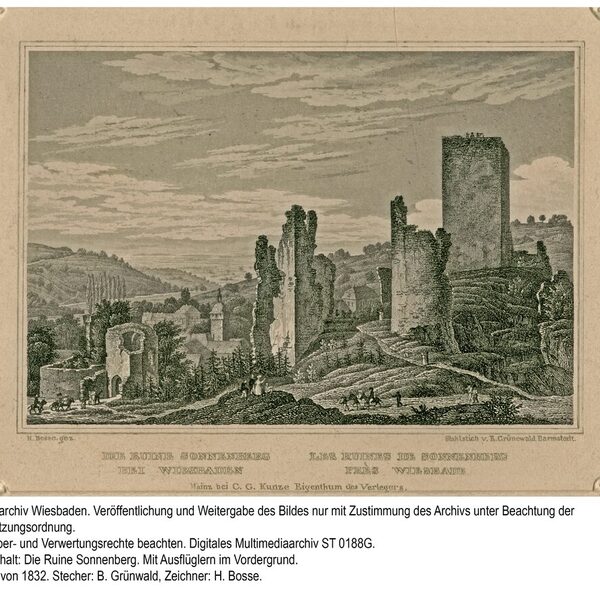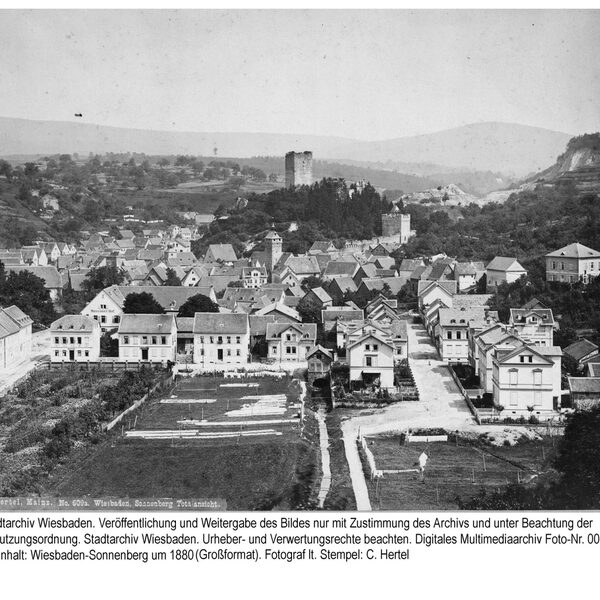Sonnenberg
Traces of Latène period settlements were found west of Rambach in the "Burg" and "Unter den Fichten" districts. During the Roman period, the road from Wiesbaden through the Sonnenberg valley to the Niedernhausen depression played a certain role. The origins of Sonnenberg are closely linked to Sonnenberg Castle.
The actual village developed from a settlement of Burgmannen, and so the naming of one of them, Ulbert von Idstein-Sonnenberg, in a document from 1208 is also the first mention of Sonnenberg, which is called "Sunnenburch" and "Sunnenberc" here. The von Sonnenbergs are mentioned until around 1351. Other Burgmannen were those of Nassau, von Stein, von Gravenrode, von Frauenstein and so on. They lived in Burgmannenhöfe, which were granted to them by the sovereign and were exempt from charges and interest, and in return were obliged to guard the castle. The Counts of Nassau themselves also owned a farm in Sonnenberg, in the "valley". In the 14th century, the castle with its small settlement of Burgmanns served as the residence and widow's seat of Countess Irmgard von Hohenlohe and Anna, wife of Count Ruprecht zu Nassau.
At the instigation of Irmgard von Hohenlohe, the second wife of Count Gerlach zu Nassau, Sonnenberg was granted town privileges by King Charles IV on July 29, 1351. In 1355, she also succeeded in forming a lordship of Sonnenberg from Sonnenberg as well as Kloppenheim and Auringen in order to ensure that her sons, who were excluded from the Nassau succession, were able to live in a manner befitting their station. The town privilege granted Sonnenberg the right to build a town wall, hold a weekly market and exercise jurisdiction. A town wall with seven towers was subsequently built, but otherwise no urban settlement developed in Sonnenberg. A mayor appointed by the sovereign was at the head of the municipal system. After the death of Countess Irmgard in 1404, the lordship of Sonnenberg ceased to exist.
Until 1605, the now "Amt" Sonnenberg was jointly owned by the Idstein and Walram lines of the Counts of Nassau, who each had it administered by their own cellars or burgraves. Sonnenberg belonged successively to Nassau-Weilburg (until 1629), Nassau-Idstein (until 1721) and Nassau-Usingen. In 1816 it was incorporated into the Duchy of Nassau and in 1866 into the Prussian state. Sonnenberg repeatedly had its municipal liberties documented, for example in 1684; however, at this time it was no longer called a town, but a "Flecken". The inhabitants repeatedly lodged complaints against the use of their town charter for hunting services by the sovereign or for guarding "maleficants" in Wiesbaden prison.
The Sonnenberg district was bordered to the east by the Rambach district, to the south by the Bierstadt district and to the west by the Wiesbaden district; expansion through clearing could therefore only take place to the north. In the period that followed, there were frequent disputes with the neighbors, who claimed that the Sonnenbergs had moved the boundary stones to their disadvantage. The manorial land had been leased to farmers or farm owners since 1620. One of their tasks was to keep the manorial estate opposite the church in good condition. The population lived from agriculture, sheep farming and horticulture; cabbage and cabbage gardens were located around the castle. A community sheep farm is mentioned in 1540.
From 1344, Sonnenberg, Auringen and Kloppenheim belonged to the Märkergenossenschaft der Höhe, and forestry was correspondingly important for the village. From 1634 onwards, forestry officials such as the wood master Johann Pfeil were based in Sonnenberg. Coal was burned in the Sonnenberg forest in the 17th and 18th centuries.
In 591, Sonnenberg counted 40 "Hausgesässe". After the Thirty Years' War, there were still twelve heads of household. In order to repopulate the depopulated village, Count Johann zu Nassau-Idstein granted those willing to move in freedom from the usual burdens for a period of 15 years. By the end of the 17th century, a large number of immigrants had arrived. Around 1700, farming predominated in Sonnenberg, with farmers working as tenants and only to a lesser extent on their own. In addition, there were day laborers, manorial officials and municipal employees. In the 18th century, on the other hand, crafts increased. A growing number of inhabitants now earned their living in the building trade, as linen weavers, basket makers or sword sweepers. There were also several millers, as Sonnenberg had an old milling tradition.
The inhabitants of the lower village were parishioners of Wiesbaden and those of the upper village of Bierstadt. A Holy Cross Chapel, built in 1429 by the knight Werner Hud, was located outside the village on the heights and played a role as a pilgrimage church later in the 15th century. At the end of the 15th century, Count Johann zu Nassau donated a chapel dedicated to St. Mary, which was elevated to parish church status in 1591. However, the endowment was far too small to support the parish priest and the parish buildings. This only changed when Rambach became a branch of Sonnenberg in 1685. The Chapel of the Holy Cross fell into disrepair after the Reformation and was demolished in 1730. The castle chapel had been abandoned for much longer. The parish church and the castle chapel each had a rectory with outbuildings, but according to a visitation report in 1591, they had all fallen into disrepair.
The parish church was rebuilt in 1830 and extensively renovated in 1934. It was destroyed in the bombing raid of 1945 and rebuilt in 1948. In 1873, a house was purchased for Catholic services, where the priest lived and services were held. In 1890, a new Catholic church was built, to which Rambach and Heßloch belonged as branches.
In 1603, a schoolmaster is mentioned for the first time, who also served as a bell ringer. Classes were held in the teacher's house. In 1697, the chancery director Graf donated 1,000 fl. for the school and the schoolmaster. The schoolhouse stood on the same site as the later valley school. The meagre endowment of the office caused a frequent change of teachers; conditions only improved at the end of the 18th century. The valley school was opened in 1827 and was attended by 139 pupils in 1829, 73 boys and 66 girls. In 1861, a second teaching post was created and the bell-ringer and sexton services were separated from it. The number of pupils doubled by 1875 and the school was extended by adding a second storey. Due to the constantly increasing number of pupils, the later Konrad-Duden-Schule was built on the Burgberg in 1904 with eight classrooms. In 1861, the administration was headed by a mayor who was assisted by a municipal accountant.
The division of the old "Waldmark zur Höhe", which was completed between 1817 and 1822 and involved the transfer of 185 hectares of forest to municipal ownership, made Sonenberg a wealthy community. The forest estate now extended from the Bahnholz to the Tennelbach valley, the Schüsselbach valley and the Goldstein valley; the people of Wiesbaden discovered it as an excursion destination.
In 1818, there were 154 families with 636 inhabitants in Sonnenberg; in 1866, there were 1,232 inhabitants in Sonnenberg, 1,080 of whom were Protestant, 114 Catholic and 38 Jewish. Around a quarter of the inhabitants were engaged in a trade.
Until 1866, Sonnenberg had belonged to the district of Wiesbaden; in 1867 it was assigned to the Mainkreis and in 1885 it became part of the newly formed district of Wiesbaden. In that year, the population was 2,000. Sonnenberg was connected to the electric streetcar in 1901 and to the sewer system in 1909. Around 1900, Sonnenberg began to develop into a preferred residential area on the outskirts of the city of Wiesbaden. Both villages were now connected by a seamless development. Sonnenberg was incorporated into Wiesbaden on 01.10.1926.
There were 115 casualties in the First World War. The town hall, the fire station and other houses were destroyed in a bombing raid on February 2 and 3, 1945.
Sonnenberg has a lively club life: The Turn- und Sportgemeinde Sonnenberg 1861, which emerged from the Turngemeinde Sonnenberg, is the oldest and largest club with around 1,500 members. This was followed in 1865 by the "Gemüthlichkeit" men's choir, now the Wiesbaden-Sonnenberg Men's Chamber Choir, and in 1875 by the Concordia 1875 e.V. men's choir. The founding of the volunteer fire department in 1896 was triggered by a major fire in Talstraße. The accordion orchestra was founded in 1950 as the harmonica orchestra and renamed in 1960. Preparations for the 600th anniversary celebrations in 1951 gave rise to the Sonnenberg local history association, which is responsible for looking after the small local history museum in the keep and making it accessible to the public.
Literature
Czysz, Sonnenberg; Festschrift 875 Jahre Sonnenberg 1126-2001.
Organizing Committee (ed.), Wiesbaden-Sonnenberg 2001.


